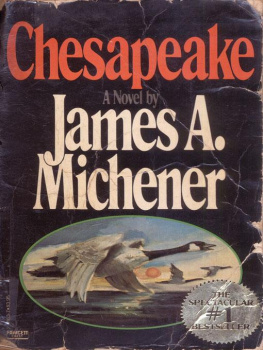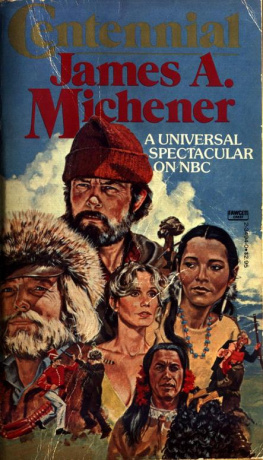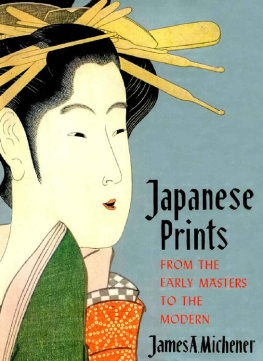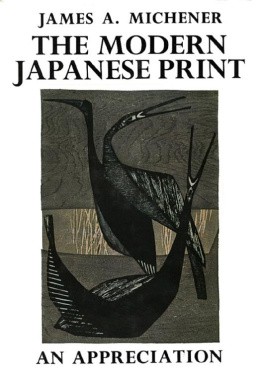James A. Michener - The Bridge at Andau: The Compelling True Story of a Brave, Embattled People
Here you can read online James A. Michener - The Bridge at Andau: The Compelling True Story of a Brave, Embattled People full text of the book (entire story) in english for free. Download pdf and epub, get meaning, cover and reviews about this ebook. year: 2015, publisher: Dial Press Trade Paperback, genre: Non-fiction / History. Description of the work, (preface) as well as reviews are available. Best literature library LitArk.com created for fans of good reading and offers a wide selection of genres:
Romance novel
Science fiction
Adventure
Detective
Science
History
Home and family
Prose
Art
Politics
Computer
Non-fiction
Religion
Business
Children
Humor
Choose a favorite category and find really read worthwhile books. Enjoy immersion in the world of imagination, feel the emotions of the characters or learn something new for yourself, make an fascinating discovery.

- Book:The Bridge at Andau: The Compelling True Story of a Brave, Embattled People
- Author:
- Publisher:Dial Press Trade Paperback
- Genre:
- Year:2015
- Rating:3 / 5
- Favourites:Add to favourites
- Your mark:
- 60
- 1
- 2
- 3
- 4
- 5
The Bridge at Andau: The Compelling True Story of a Brave, Embattled People: summary, description and annotation
We offer to read an annotation, description, summary or preface (depends on what the author of the book "The Bridge at Andau: The Compelling True Story of a Brave, Embattled People" wrote himself). If you haven't found the necessary information about the book — write in the comments, we will try to find it.
James A. Michener: author's other books
Who wrote The Bridge at Andau: The Compelling True Story of a Brave, Embattled People? Find out the surname, the name of the author of the book and a list of all author's works by series.
The Bridge at Andau: The Compelling True Story of a Brave, Embattled People — read online for free the complete book (whole text) full work
Below is the text of the book, divided by pages. System saving the place of the last page read, allows you to conveniently read the book "The Bridge at Andau: The Compelling True Story of a Brave, Embattled People" online for free, without having to search again every time where you left off. Put a bookmark, and you can go to the page where you finished reading at any time.
Font size:
Interval:
Bookmark:

Praise for
James A. Michener
Precise, vivid.
The Atlantic Monthly
Dramatic, chilling, enraging.
San Francisco Chronicle
Superb.
The Kirkus Reviews
Highly recommended reading.
Library Journal
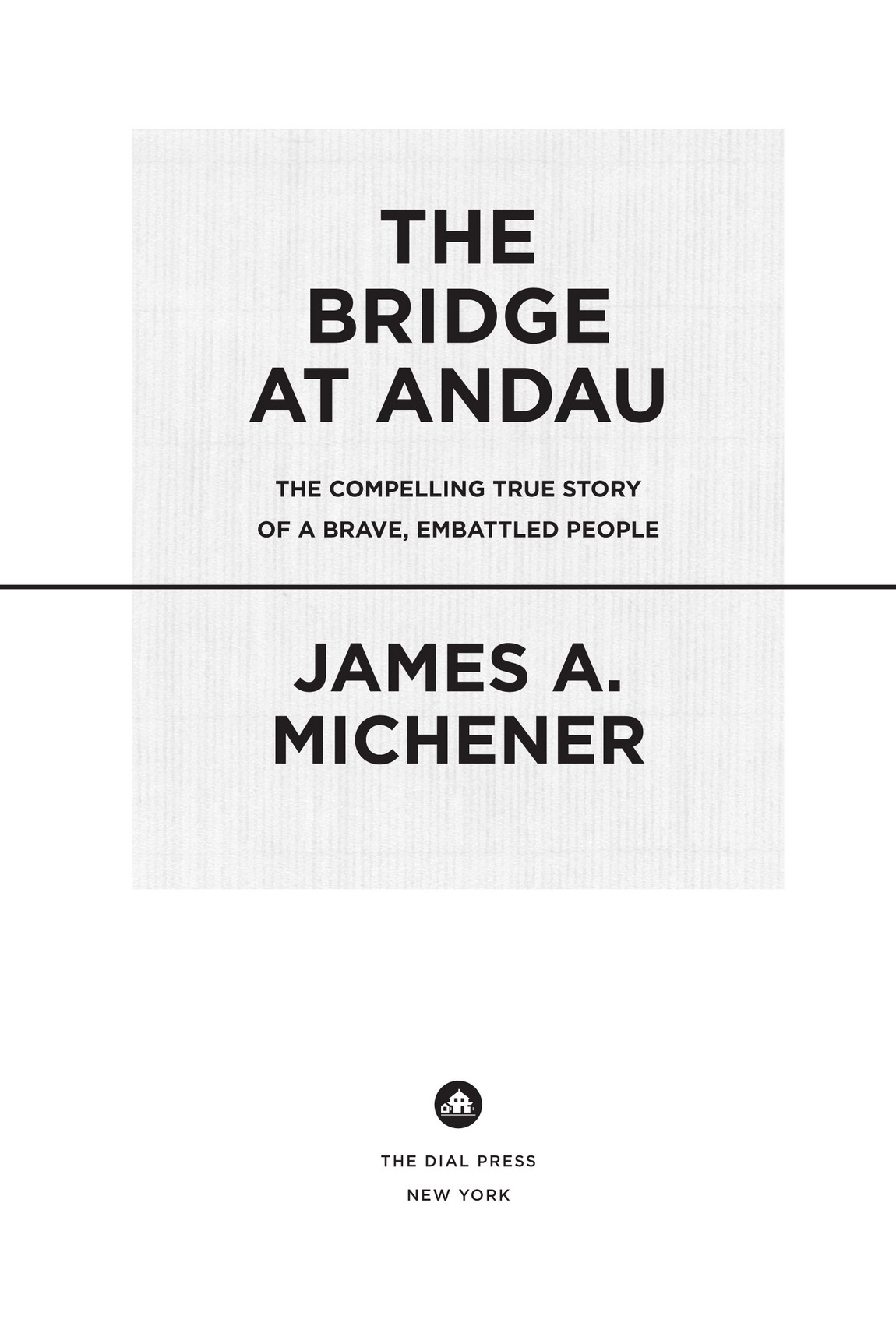
The Bridge at Andau is a work of historical fiction. Apart from the well-known actual people, events, and locales that figure in the narrative, all names, characters, places, and incidents are the products of the authors imagination or are used fictitiously. Any resemblance to current events or locales, or to living persons, is entirely coincidental.
2015 Dial Press eBook Edition
Copyright 1957 by James Michener
Excerpt from Hawaii copyright 1959 and copyright renewed 1987 by James A. Michener
Introduction copyright 2014 by Steve Berry
All rights reserved.
Published in the United States by The Dial Press, an imprint of Random House, a division of Penguin Random House LLC, New York.
D IAL P RESS and the H OUSE colophon are registered trademarks of Penguin Random House LLC.
Originally published in hardcover in the United States by Random House, an imprint and division of Random House LLC, in 1957.
ISBN 9780812986747
eBook ISBN 9780804151481
www.dialpress.com
246897531
eBook design adapted from printed book design by Carole Lowenstein
Cover design: Pete Garceau
Cover image credit: Erich Lessing/Magnum Photo
v4.1_r3
a
I grew up in the 1960s, a time when the extent of reading material for kids was, to say the least, limited. R. L. Stine, J. K. Rowling, Suzanne Collins, and so many others had yet to come along. In fact, what we now know as the young adult genre had yet to be invented. Back then, at least for me, it was Hardy Boys and Nancy Drew. A limited selection, but what gems those tales wereeach loaded with action, adventure, secrets, and conspiracies. Wondrous stories to fuel young imaginations. I devoured them.
Then one day when I was sixteen years old, a friend handed me a dog-eared paperback copy of Hawaii by James Michener. Its thousand pages immediately intimidated me, as did the small print. Id never seen so much information packed into one book. The opening sentence alone contained thirty-six wordsmonstrous in comparison to the prose of Franklin W. Dixon.
But what a sentence: Millions upon millions of years ago, when the continents were already formed and the principal features of the earth had been decided, there existed, then as now, one aspect of the world that dwarfed all others.
I kept reading.
What unfolded was a saga spanning many centuries that described how a tiny group of islands in the Pacific Ocean were formed by nature and then settled by man. The epic involved Polynesians, Chinese, Japanese, Europeans, and Americans. Its massive chapters, hundreds of pages long, featured one expansive episode after anothereach intertwinedforming a chronicle that defined both the land and its culture. I read it cover to cover. Then I found more books by this guy Michener and read every one. Eventually, I started collecting them, and now, more than forty years later, I own a first edition of each, save oneTales of the South Pacific. That book is hard to find. Only a few thousand were printed and, if by some miracle one of those 1947 first editions can be found, the price is through the roof. I keep every one of my Michener books prominently displayed, wrapped in plastic. I see them every day. They are a source of pride and comfort. Today, I write modern-day thrillers in which history plays a central role. Without question, the seed for that technique was planted the day I discovered Hawaii.
James Michener led an incredible life. Born in 1907, he was orphaned but was soon adopted by a woman named Mabel Michener, who was already raising two other children. Some of his biographers have hypothesized that he was actually Mabels natural son, the adoption story used to protect both of their reputations. No one knows the truth, and as an adult Michener refused to comment on the subject.
By the time he turned ten, the family had moved to Bucks County, Pennsylvania. They were poor, barely able to put food on the table. His classmates, and even a teacher or two, tormented Michener about the secondhand clothes and toeless sneakers he wore every day. Later in life he recounted that taunting with a sly smile and a twinkle in his eye. He would say that those early years instilled in him an appreciation for life that he never forgot. They taught him about living simply and not attaching too much value to material things. And though he eventually earned hundreds of millions of dollars from writing, he always feared ending up poor.
Before hed even reached twenty years of age, Michener had traveled across the country in boxcars, by thumbing rides, or simply by walking. He worked in carnival shows and other odd jobs, and he visited all but three states. Of that time, he wrote in his 1991 autobiography, The World Is My Home, Those were years of wonder and enchantment. Some of the best years I would know. I kept meeting American citizens of all levels who took me into their cars, their confidence and often their homes. He would also say that those wandering years spurred inside him an insatiable curiosity about people, cultures, and faraway lands.
In 1925 he entered Swarthmore College, a prestigious Quaker institution, on a four-year scholarship, graduating with highest honors. He attended graduate school in Scotland, then returned home and taught at a school in Bucks County. He eventually ended up in New York City, editing textbooks at Macmillan Publishing.
World War II changed everything. At age forty Michener enlisted in the navy, where he discovered the enchanting South Pacific. He earned the rank of lieutenant commander and was made a naval historian, assigned to investigate cultural problems on the various islands. A near-fatal crash landing in French New Caledonia altered the course of his life. He wrote in his autobiography, As the stars came out and I could see the low mountains I had escaped, I swore: Im going to live the rest of my life as if I were a great man. And despite the terrible braggadocio of those words, I understood precisely what I meant.
That brush with death also made him realize what every soldier was experiencing during the war, and that one day, when the danger had passed, people might want to recall those things. So each night he began writing down observations, recording comments, describing people and places. Fifty years later, in 1991, he said:
Sitting there in the darkness, illuminated only by the flickering lamplight, I visualized the aviation scenes in which I had participated, the landing beaches Id seen, the remote outposts, the exquisite islands with bending palms, and especially the valiant people Id known: the French planters, the Australian coast watchers, the Navy nurses, the Tonkinese laborers, the ordinary sailors and soldiers who were doing the work, and the primitive natives to whose jungle fastnesses I had traveled.
All of that became Tales of the South Pacific.
The story of how that first manuscript made it to print is typical Micheneran unexpected combination of skill, determination, and luck. Using a pseudonym, he submitted the work to Macmillan, the publisher hed worked for before enlisting. He omitted his name because he knew the company had a strict policy against publishing anything by an employee. Once the war was over he definitely intended to return to work there, but at the time of the submission he was technically a naval officer and not an employee. So the company bought the book, which was published in 1947. One year later
Font size:
Interval:
Bookmark:
Similar books «The Bridge at Andau: The Compelling True Story of a Brave, Embattled People»
Look at similar books to The Bridge at Andau: The Compelling True Story of a Brave, Embattled People. We have selected literature similar in name and meaning in the hope of providing readers with more options to find new, interesting, not yet read works.
Discussion, reviews of the book The Bridge at Andau: The Compelling True Story of a Brave, Embattled People and just readers' own opinions. Leave your comments, write what you think about the work, its meaning or the main characters. Specify what exactly you liked and what you didn't like, and why you think so.

